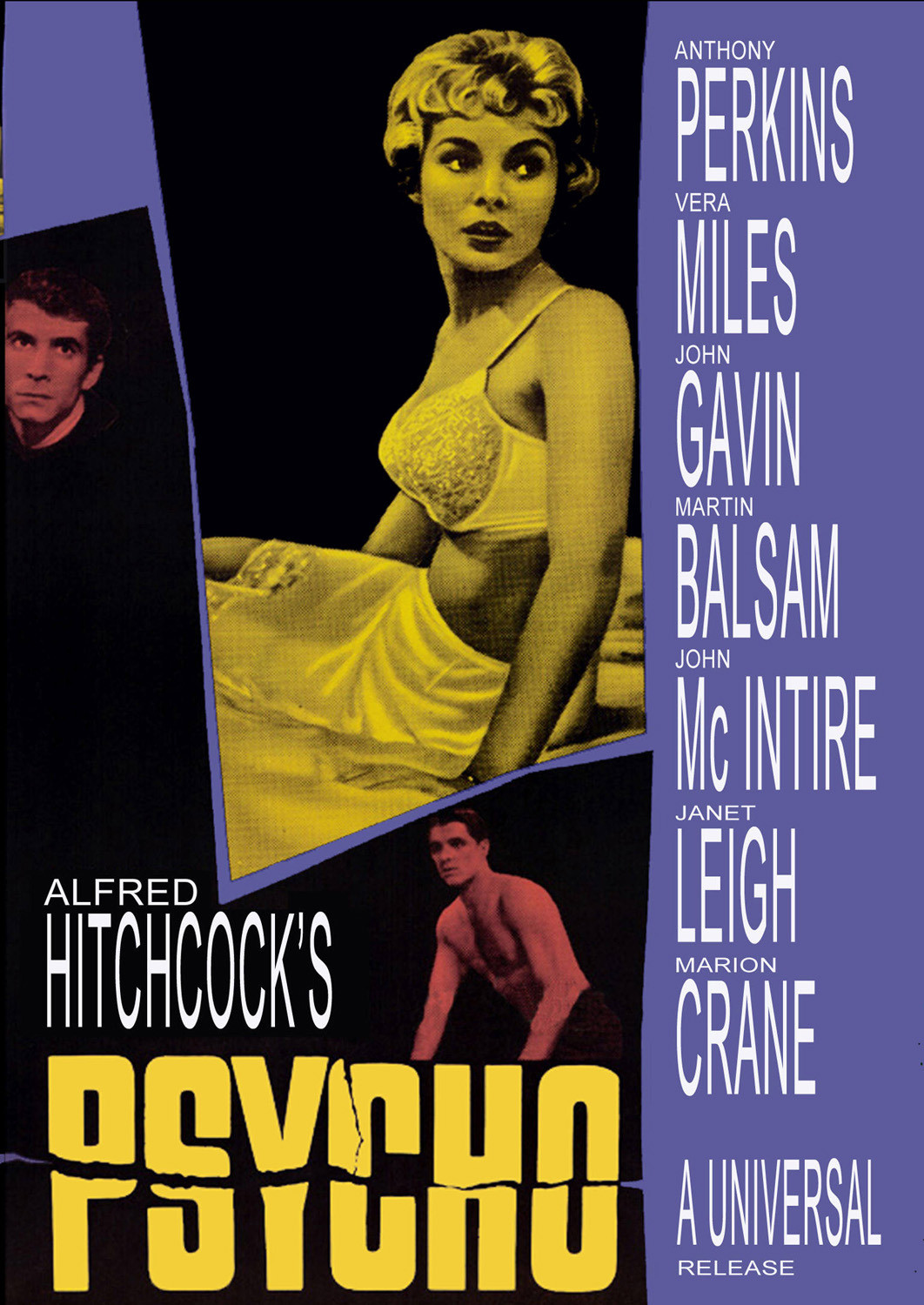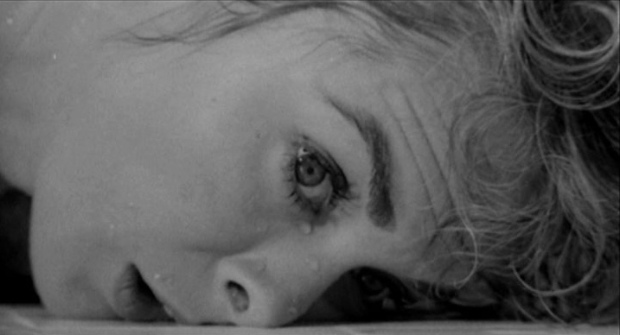
Figure 1. Psycho Poster Art
Psycho works very much like a game of cat & mouse, we know that the inevitable moment of terror is on its way but the moment of action is created with rapid cuts scaring us with threat - a montage of murder as opposed to the act itself. The films inner monologues are also a stroke of genius by Hitchcock, revealing a level of ambiguity from the films cast.
•Directed by: Alfred Hitchcock
•Written by: Joseph Stefano & Robert Bloch
•Cast: Anthony Perkins as Norman Bates, Janet Leigh as Marion Crane, Vera Miles as Lila Crane, John Gavin as Sam Loomis, Martin Balsam as Detective Milton Arbogast & John McIntire as Chambers the sheriff
•Genre: Drama, Horror, Mystery & Suspense, Classics
•Duration: 109 Minutes (aprox)

Figure 2. "A man should have a hobby”
One could assume Psycho to be based on the Freudian psychopath with a rather child like lunatic Norman Bates (Anthony Perkins) immortalising his mother by killing her, only to commit evil acts on her behalf. The true narrative for psycho begins with a rather innocent Lila Crane finding her way to a hotel off the interstate; she is killed shortly after her arrival by a woman when she is bathing. After investigator Milton Arbogast goes missing Marion Crane & Sam Loomis decide to delve deeper by staying at the motel where they meet the true Psycho - Norman Bates. Reviewer David Nusair observes:
“Hitchcock, working from a script by Joseph Stefano, offers up an opening half hour that boasts the qualities of a lurid melodrama and hardly even hints at the horror to follow”. (Nusair: 2010)The whole scenario is creepy mainly because the narrative doesn’t start the way one would imagine & changes significantly in the second act to become something else entirely. Had the film not have the name psycho we would be expecting another type of story. The questions in the name only begin to make themselves apparent with the prescience of a definitive act of murder which is cut in a montage that appear almost directly from storyboard panels. One could not help but notice the sensitivity to nudity that was considered which appears very second in nature when one weighs the fact that a murder has just happened on screen.

Figure 3. "We all go a little mad sometimes”
The thing that truly defines Psycho is its use of inner monologues a good example of this is where Lila Crane is seen leaving town. She plays out scenarios in her mind which convey people who think of her as suspicious carrying out conversations after she has left, this is very effective as it sparks internal deliberation, things that we feel on a day to day basis. With people weighing good and bad decisions, trying to draw conclusions to those moments that have gone & may never return. In Lila’s case the monologue was of fear, her way of internalising it but in the case of Norman the monologue was strategy of a mental schizophrenic, with a female voice laying out her demands conveying to the audience that Norman Bates has mentally become his mother. Authors Thomas Leitch & Leland Poague observe:
“The missing object that animates suspense throughout the film turns out to have no substantial content. It is nothing but an aspect of Norman’s psyche”. (Leitch & Poague: 2011)This moment is particularly foreign to us as we have nothing to attribute this mental ghost to. The audience are not shown any elements or Normans past just as we wouldn’t to a stranger & it works almost as if no level of reasoning would cause us to think of ourselves as our mothers. The film simply wouldn’t be able to live up to that image which causes one to descend that far. The lack of a physical body confuses us & binds that identity to Norman, her skeleton is nothing more than a trinket that reveals her true death to the audience & Norman as her successor.

Figure 4. "I’ll just sit here and be quiet, just in case they do... suspect me”
Psycho is a well shot & coordinated effort in which nothing is truly gruesome or over staged, one could argue that the film was about the thrill of the scare as opposed to the thrill of the kill. Let us consider the iconic shower sequence which finds Lila Crane killed by a crazed unknown. The act itself was unsuspected mainly because to the audience the only man that could have had the motive to do so was in his house. It is quite possible for the audience to think of him as a suspect but even that thought is obscured when he finds the body & begins cleaning it up in panic. Reviewers Dan Hunter & Jason Knowles observe:
“From the masterful editing of the shower scene montage (in which the knife never directly enters Leigh's flesh), to the quick-cut editing of Arbogast's demise in the Bates house on the hill, Hitchcock meticulously devised a film which "suggested" the individual horror within the minds of each audience member”. (Hunter & Knowles: 1998)The shower scene was edited to reveal limited information to its viewers, which up until that point thought they were enduring an atypical drama albeit with a strange name. The speed of the montage aided in no small part to the music inspires fear. The shots are cut only revealing a hint of suggestion flowing into another rapid movement, no information regarding the identity of the killer is revealed & the dripping blood conveys impact on the skin when it is obvious on reflection that her skin has not been touched. It’s fair to say that on reflection Hitchcock’s decision to hide Lila’s nudity was probably a crude decision to conceal the fact that her body hadn’t been stabbed at all. The truth is in film something doesn’t have to physically happen to convey suggestion, one only needs the right angles & cuts to convey illusion as a reality, Psycho does just that.
List of Illustrations
Figure 1. Psycho Poster Art. (com) [Online image]. At: http://collider.com/wp-content/uploads/pyscho-movie-poster.jpg (Accessed on: 15/02/12)
Figure 2. A man should have a hobby. (com) [Online image]. At: http://www.planetvideo.com.au/blog/2010/06/25/hitchcock-psycho-thumb.jpg
(Accessed on: 15/02/12)
Figure 3. We all go a little mad sometimes. (com) [Online image]. At: http://www.mardecortesbaja.com/PsychoEyeBaja.jpg (Accessed on: 15/02/12)
Figure 4. I’ll just sit here and be quiet, just in case they do... suspect me. (com) [Online image]. At:
http://www.hitchcockfans.com/images/gallery/screenshots/psycho17.jpg
(Accessed on: 15/02/12)
Bibliography
Nusair, David. (2010) Psycho Review At:
http://reelfilm.com/htchcock.htm#psycho (Accessed on: 15/02/12)
Leitch, Thomas & Poague Leland. (2011) A Companion to Alfred Hitchcock, 1st Edition, Published in the United Kingdom (Accessed on: 15/02/12)
Hunter, Dan & Knowles, Jason. (1998) Psycho Review. At: http://www.terrortrap.com/topten/psycho/
(Accessed on: 15/02/12)

No comments:
Post a Comment